Very similar decisions were made - width and height of the box were kept to
absolute minimum and determined by woofer width and driver vertical spacing.
Hi,
Except the BB is not designed to go near / against a wall.
rgds, sreten.
Hi,
Except the BB is not designed to go near / against a wall.
rgds, sreten.
Does it matter much since his will be active with DSP?
In my opinion it is a better solution to do the necessary eq'ing in DSP than by using passive components in a speaker-level crossover.
The precision can be much higher and the inherent flexibility in combination with measuring should give a fair degree of freedom with regards to positioning.
Although I'm sure the small form-factor Scanspeak tweeters are very good- measurements are certainly very nice- I think the SB neo unit is being a little underestimated. Admittedly I've only heard it in commercial systems in unfamiliar surroundings, but on both occasions the hf was very good by any reasonable standard. It depends on how much money you have really. The Scan may be a bit better, but it is quite a lot more expensive. Nice to have a range of choices though!
Does it matter much since his will be active with DSP?
In my opinion it is a better solution to do the necessary eq'ing in DSP than by using passive components in a speaker-level crossover.
The precision can be much higher and the inherent flexibility in combination with measuring should give a fair degree of freedom with regards to positioning.
I use mini dsp
And as long as my speakers were near the front wall, bass performance really suffer. The bass was super bad until 3 feet from front wall. Had 15 db peaks, now my biggest peak is 7-8 db 🙂
u can contour your response, with almost
no BSC, with sealed you may get better result with higher f3 but still
can reach low in f10.
if there's a midbass hump around 100-300, this can be compensated within crossover. its not easy, but doable.
no BSC, with sealed you may get better result with higher f3 but still
can reach low in f10.
if there's a midbass hump around 100-300, this can be compensated within crossover. its not easy, but doable.
I use mini dsp
And as long as my speakers were near the front wall, bass performance really suffer. The bass was super bad until 3 feet from front wall. Had 15 db peaks, now my biggest peak is 7-8 db 🙂
Well I didn't and never would say that DSP gives you complete freedom and can solve room problems (it can't) but it is much more flexible, quicker and in the long run cheaper than messing about with passive components.
I would not have bothered going for the R29/70000 tweeter if I did not have it already.
See Zaph's Tweeter Mismash for good alternatives:
Zaph|Audio
Peerless 810921???>
See Zaph's Tweeter Mismash for good alternatives:
Zaph|Audio
Peerless 810921???>
Thanks for the advice.
I have pushed ahead with this project, as despite the possible problems I believe it will best suite my needs.
The box plan is sorted and includes cross bracing and extensive damping with bitumen/aluminium sheets (3mm):

It will be MDF 18mm with oak bracing. I have bought some black walnut veneer to finish it.
I will have 6 binding posts on the back of each speaker, then run them with professional power amps and initially a spare DBX 234xs - which whilst it cannot compensate for baffle step, complex crossover slopes or EQ, will give me an idea how it all sounds prior to my final decision on implementing a 'proper crossover' - most likely digital.
As I am using very high end mid ranges with the 12MU scanspeaks, I have spent quite some time experimenting with them in various 1.5-3 litre sealed enclosures. I have been listening to them using the DBX to limit the freq input and trying to decide what sounds the most natural. I have tried MDF boxes, tubes and cones.
So far my favourite enclosure is a 2 litre one, made with a 125mm drainpipe tube. This is wrapped in the bitumen/aluminium sheeting on the outside, and multiple reducing widths of felt sheet on the inside in concentric circles, so that the inside cavity is shaped like a 'bullet'. This seems to really absorb the back wall reflections. Its difficult to photo, as the felt and bitumen are all black so here is a picture:

By cutting different widths of thick self adhesive felt and rolling them up, from narrow to thick, it creates a curved felt rear wall, that is then 'capped' with a circle of MDF glued in place. I am really pleased with this design so far - it seems to dampen nearly all the rearward energy with minimal colouration - I should also mention that the cavity between the speaker and felt is stuffed with fibreglass - I am now trying different densities to find the best balance.
I have pushed ahead with this project, as despite the possible problems I believe it will best suite my needs.
The box plan is sorted and includes cross bracing and extensive damping with bitumen/aluminium sheets (3mm):

It will be MDF 18mm with oak bracing. I have bought some black walnut veneer to finish it.
I will have 6 binding posts on the back of each speaker, then run them with professional power amps and initially a spare DBX 234xs - which whilst it cannot compensate for baffle step, complex crossover slopes or EQ, will give me an idea how it all sounds prior to my final decision on implementing a 'proper crossover' - most likely digital.
As I am using very high end mid ranges with the 12MU scanspeaks, I have spent quite some time experimenting with them in various 1.5-3 litre sealed enclosures. I have been listening to them using the DBX to limit the freq input and trying to decide what sounds the most natural. I have tried MDF boxes, tubes and cones.
So far my favourite enclosure is a 2 litre one, made with a 125mm drainpipe tube. This is wrapped in the bitumen/aluminium sheeting on the outside, and multiple reducing widths of felt sheet on the inside in concentric circles, so that the inside cavity is shaped like a 'bullet'. This seems to really absorb the back wall reflections. Its difficult to photo, as the felt and bitumen are all black so here is a picture:

By cutting different widths of thick self adhesive felt and rolling them up, from narrow to thick, it creates a curved felt rear wall, that is then 'capped' with a circle of MDF glued in place. I am really pleased with this design so far - it seems to dampen nearly all the rearward energy with minimal colouration - I should also mention that the cavity between the speaker and felt is stuffed with fibreglass - I am now trying different densities to find the best balance.
This design has one problem - the bass driver induces strong floor reflection. It would be better to double it or place a single driver lower, very close to the foor like this Kaiutinrakennusohje - Kolmitieklassikko - perinteinen lattiakaiutin 12-tuumaisella bassolla | AudioVideo.fi
An externally hosted image should be here but it was not working when we last tested it.
Perfect suggestion.
Would raise the floor bounce to well above the operating range of the woofer in this arrangement nullifying the effect. If driver is placed low enough <3" from the floor an additional 6dB boost can be realized. Sometimes this can add too much and cause boom. Use of adjustable feet or ontop of something to adjust the height is best. Even a 2" difference can be substantial.
Diver spacing should be 1/4 wavelength at the crossover point from the mid to the woofer.
Last edited:
 Copyrighted images removed. Please guys, if you didn't make the drawing and don't have the permission of the copyright holder, don't post it.
Copyrighted images removed. Please guys, if you didn't make the drawing and don't have the permission of the copyright holder, don't post it.So I have been busy pushing ahead with this project. As you know from this thread the aim was to create a sealed system.
Three way (with multiple sub assistance so really 4 way) to give dynamics and priority to mid-range clarity.
To use the 12MU scanspeak as the mid, as I think it is one of the best available. I have also discussed earlier my reasoning behind selecting the woofer and tweeter based on complementing and designing around the 12MU.
I have gone for an active design to allow flexibility with crossovers and EQ in the future.
To start with I will be using the speakers with an Omnitronic 6 ch power amp (basic pro audio amp, with reasonable specs (30v slew, 150W per channel, 0.5% distortion etc). And a 3 way Dbx analogue crossover. This is because I got the amp for under £100 second hand, and the crossover for free, and will allow me to 'play' whilst I save and think about a more permanent solution.
So to begin with, as the mid is the central focus to this design I spend ages coming up with the best 2 litre sealed enclosure for it:
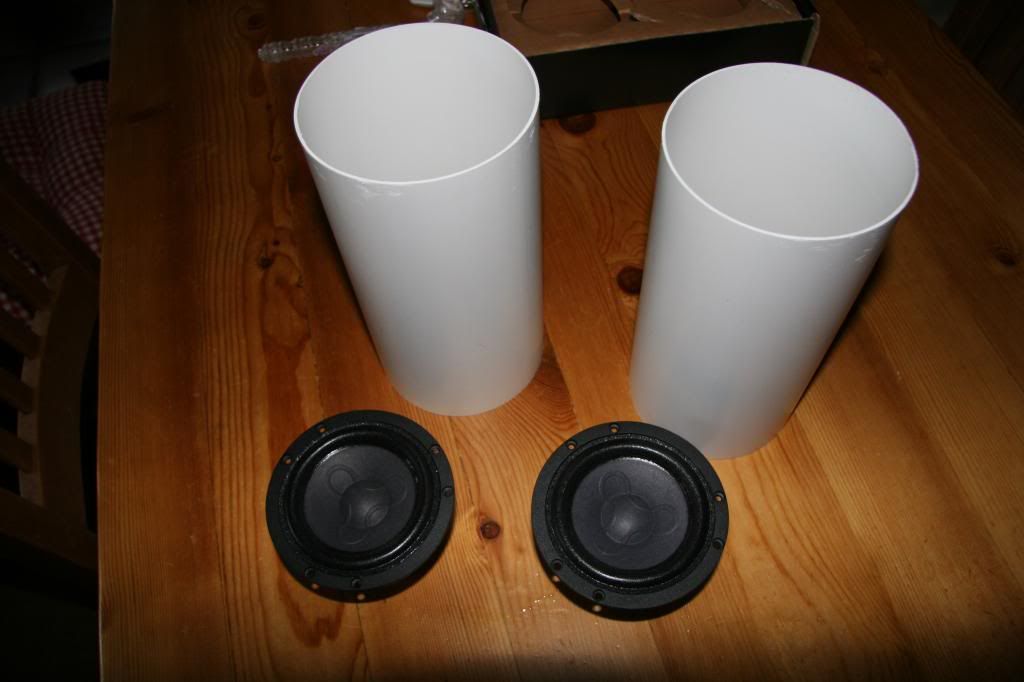
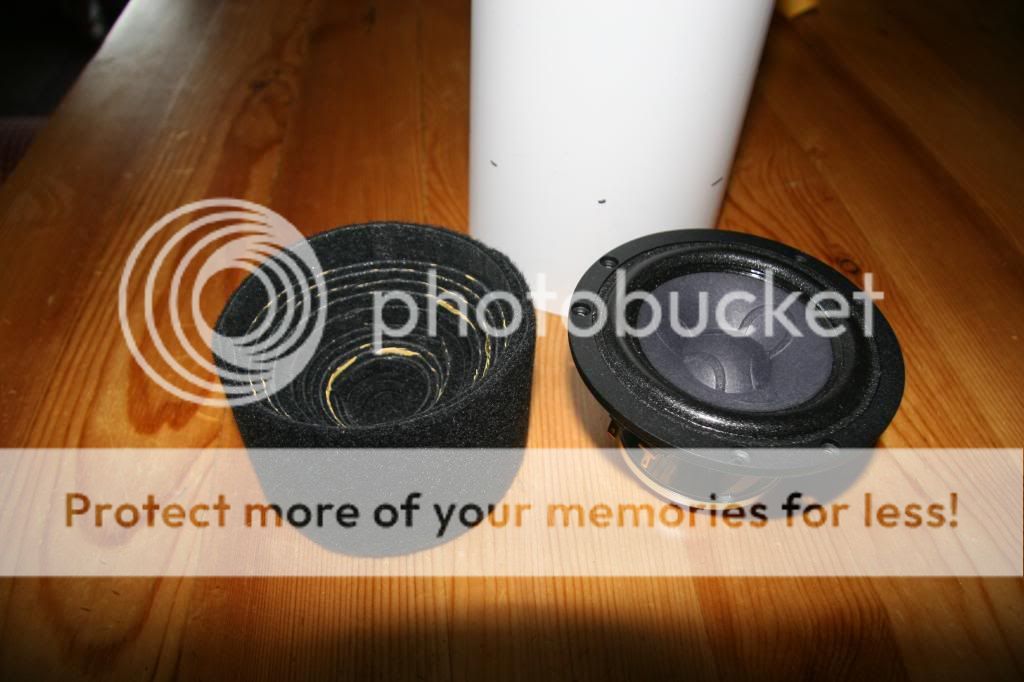
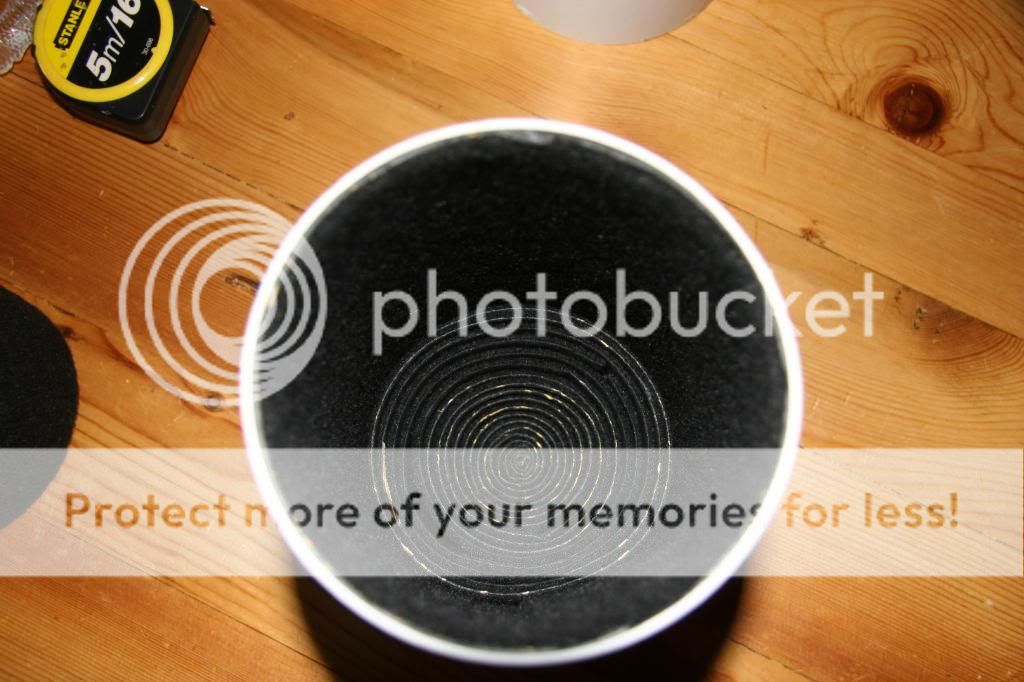
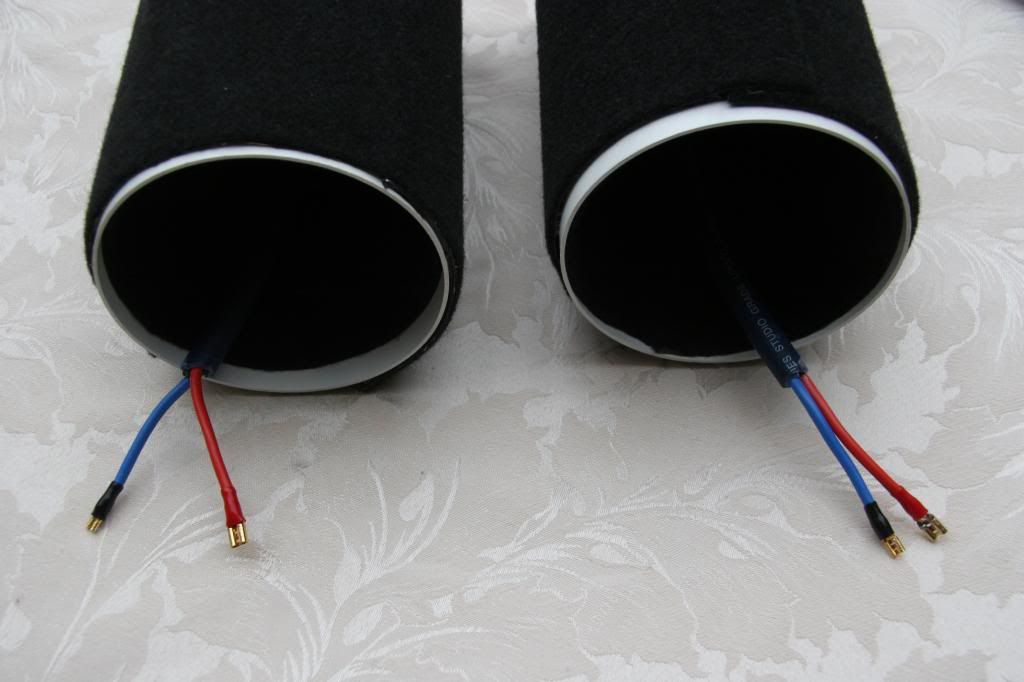
These are photos of what I was trying to explain earlier!
It is then stuffed with 1lb/cubic foot density of fibreglass insulation.
The tubes are dampened with multiple layers in a felt/bitumen/plastic tube/bitumen/felt, order. And following all those layers and the stuffing it was an incredibly damped enclosure, with no audible internal reflections. I was particularly enamored with the 'felt roll' for the back wall which worked very well.
Three way (with multiple sub assistance so really 4 way) to give dynamics and priority to mid-range clarity.
To use the 12MU scanspeak as the mid, as I think it is one of the best available. I have also discussed earlier my reasoning behind selecting the woofer and tweeter based on complementing and designing around the 12MU.
I have gone for an active design to allow flexibility with crossovers and EQ in the future.
To start with I will be using the speakers with an Omnitronic 6 ch power amp (basic pro audio amp, with reasonable specs (30v slew, 150W per channel, 0.5% distortion etc). And a 3 way Dbx analogue crossover. This is because I got the amp for under £100 second hand, and the crossover for free, and will allow me to 'play' whilst I save and think about a more permanent solution.
So to begin with, as the mid is the central focus to this design I spend ages coming up with the best 2 litre sealed enclosure for it:




These are photos of what I was trying to explain earlier!
It is then stuffed with 1lb/cubic foot density of fibreglass insulation.
The tubes are dampened with multiple layers in a felt/bitumen/plastic tube/bitumen/felt, order. And following all those layers and the stuffing it was an incredibly damped enclosure, with no audible internal reflections. I was particularly enamored with the 'felt roll' for the back wall which worked very well.
This mid enclosure was then mounted to the baffle with flexible glue and to the central cross bracing in order to ensure it was solidly mounted to the main cabinet.

The main enclosure is as per my previous design in 18mm MDF and was also extensively braced with oak battons and lined with 3mm bitumen/aluminum sound deadening sheet.

The main enclosure is as per my previous design in 18mm MDF and was also extensively braced with oak battons and lined with 3mm bitumen/aluminum sound deadening sheet.
The whole cabinet was then veneered with black walnut, and stuffed at the same density as the mid enclosure with fibreglass. I wish I had bought the paper backed veneer, as this was my first veneering attempt, and it was plain cut real wood 0.6mm......very dry and fragile!
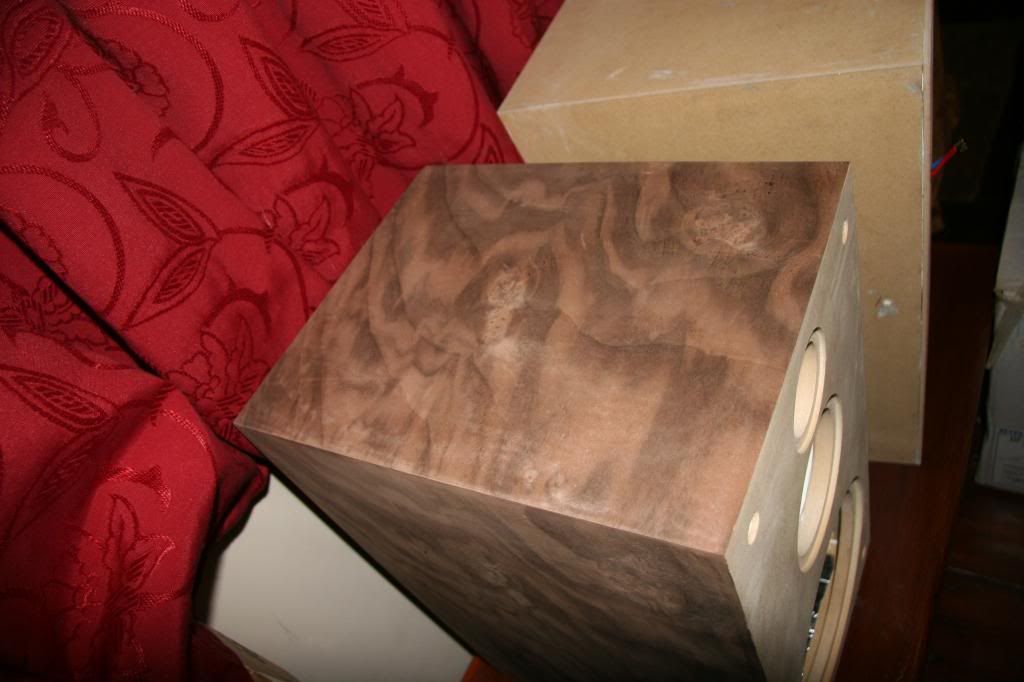
An externally hosted image should be here but it was not working when we last tested it.

I then sprayed the baffles in satin black after sanding, priming, etc and mounted the drivers.
It uses Van Damme blue studio grade 4mm cable throughout, and has gold plated binding posts to allow connect to the power amps.
Here is a picture comparing it to my Focal CMS 65 Studio monitors for scale....
You can see whilst I have tried to keep them as compact as possible, they are not small......
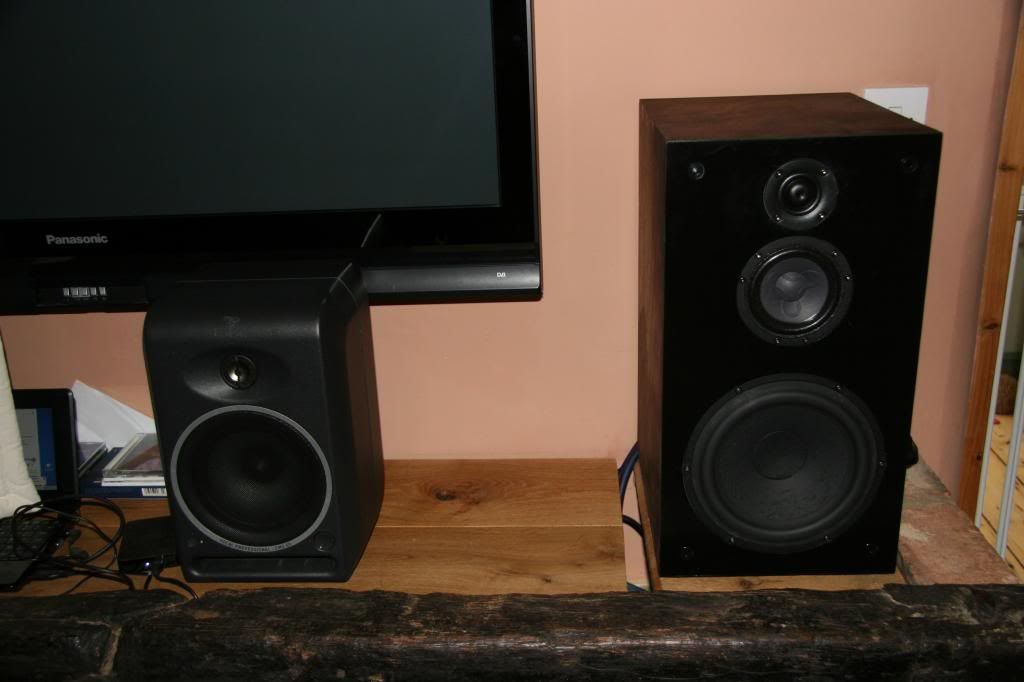
It uses Van Damme blue studio grade 4mm cable throughout, and has gold plated binding posts to allow connect to the power amps.
Here is a picture comparing it to my Focal CMS 65 Studio monitors for scale....
You can see whilst I have tried to keep them as compact as possible, they are not small......

They are resting on 4cm sorbothane hemispheres which are correctly loaded with the weight of the speakers (approx 25kg) to allow the best mitigation of vibrations. They still need another few coats of danish oil, then hard wax.
First listening impressions with pink noise and an spl meter for setting power amp levels, and LR4 active crossovers at 280 hz and 2000 hz are...incredible. I won't go into a lot of hyperbole, but they are significant better then the focal CMS65, and that is with bog standard LR4 slopes and a cheap pro audio amp. I think the quality of the drivers is what shines through.
My wife was initially very skeptical due to the size increase in the sitting room, won't turn them off, and says they are 'much more relaxing to listen to'. Possibly a sign of less high order distortion?
I suspect they don't need a lot of eq'ing as each driver is very flat within it's pass band with no there are no break-ups/nasties anywhere close to the crossover points.
I have used a I-pad a frequency analyser app to roughly look at the freq spectrum (surprisingly accurate with the focal CMS 65s and using their EQ adjustments to see if the I-pad could pick up the various shelving changes), and they are as flat as the Focals - something I was surprised by.
I am currently looking at mics and measurement software/sound cards to do the proper measurements - I didn't see a lot of point in investing in this prior to having a speaker to measure!
First listening impressions with pink noise and an spl meter for setting power amp levels, and LR4 active crossovers at 280 hz and 2000 hz are...incredible. I won't go into a lot of hyperbole, but they are significant better then the focal CMS65, and that is with bog standard LR4 slopes and a cheap pro audio amp. I think the quality of the drivers is what shines through.
My wife was initially very skeptical due to the size increase in the sitting room, won't turn them off, and says they are 'much more relaxing to listen to'. Possibly a sign of less high order distortion?
I suspect they don't need a lot of eq'ing as each driver is very flat within it's pass band with no there are no break-ups/nasties anywhere close to the crossover points.
I have used a I-pad a frequency analyser app to roughly look at the freq spectrum (surprisingly accurate with the focal CMS 65s and using their EQ adjustments to see if the I-pad could pick up the various shelving changes), and they are as flat as the Focals - something I was surprised by.
I am currently looking at mics and measurement software/sound cards to do the proper measurements - I didn't see a lot of point in investing in this prior to having a speaker to measure!
An externally hosted image should be here but it was not working when we last tested it.
Very nice indeed! Looks like you went with the SB tweeter- I'm glad it worked out well! I really must buy a pair myself...
I think they sound wonderful! As smooth as the graphs suggest - get some! The focals have magnesium/aluminium alloy inverted dome tweeters which are supposed to be very good.......but I feel the SB tweeters sound much better (I have lived with the Focals for years).
I have heard a number of scanspeak tweeters over the years, and I honestly think these SB neos are incredible value for money......I chose them over all the small flange scanspeak tweeters and this was not a cost based decision.
I have heard a number of scanspeak tweeters over the years, and I honestly think these SB neos are incredible value for money......I chose them over all the small flange scanspeak tweeters and this was not a cost based decision.
Excellent! As I said earlier in the thread, I have listened to them, but in an unfamaliar context. I keep mentioning the SBs on threads because the treble in that system sounded exceptionally good- thanks for the confirmation! I will definately get a pair to try.
Hi bushmeister, I have been watching your progress with interest and am happy to hear you are getting good results with the Scan drivers. As you are using DSP (so changing things is relatively easy) may I suggest you try raising your MF/HF crossover point up to 4.5Khz?
This will move any phasing issues out of the main vocal range and in to the sibilant area where is is far less obvious and will increase the power handing of the tweeter.
It may not be "Text Book" correct but the whole point of a loudspeaker is to sound good and, after a lot of trials with this mid range driver when I was designing the SP1M, I know it sounds good even at 4.5Khz!!
This will move any phasing issues out of the main vocal range and in to the sibilant area where is is far less obvious and will increase the power handing of the tweeter.
It may not be "Text Book" correct but the whole point of a loudspeaker is to sound good and, after a lot of trials with this mid range driver when I was designing the SP1M, I know it sounds good even at 4.5Khz!!
- Status
- Not open for further replies.
- Home
- Loudspeakers
- Multi-Way
- Sealed three way monitor - anyone spot any probs before I start?